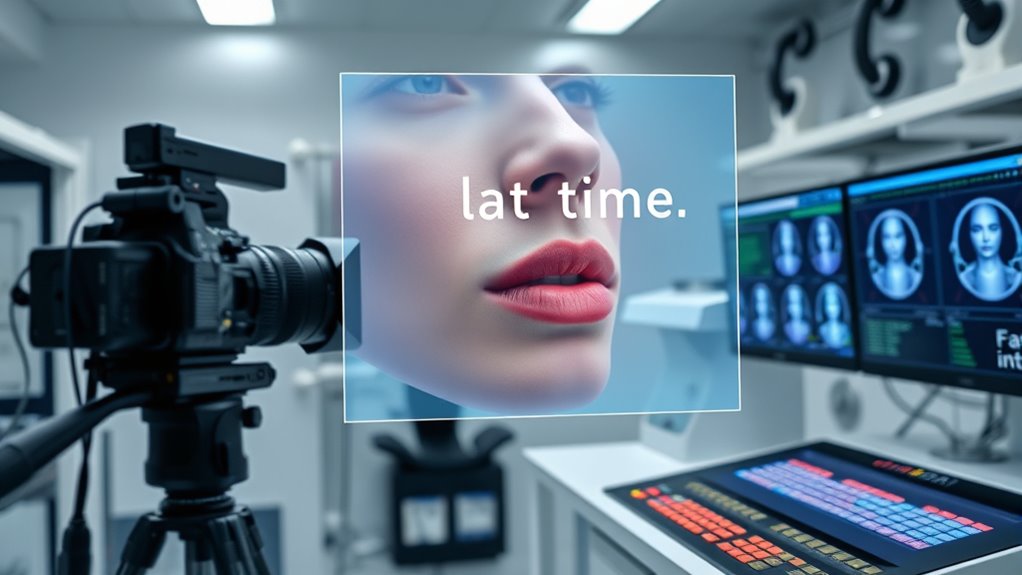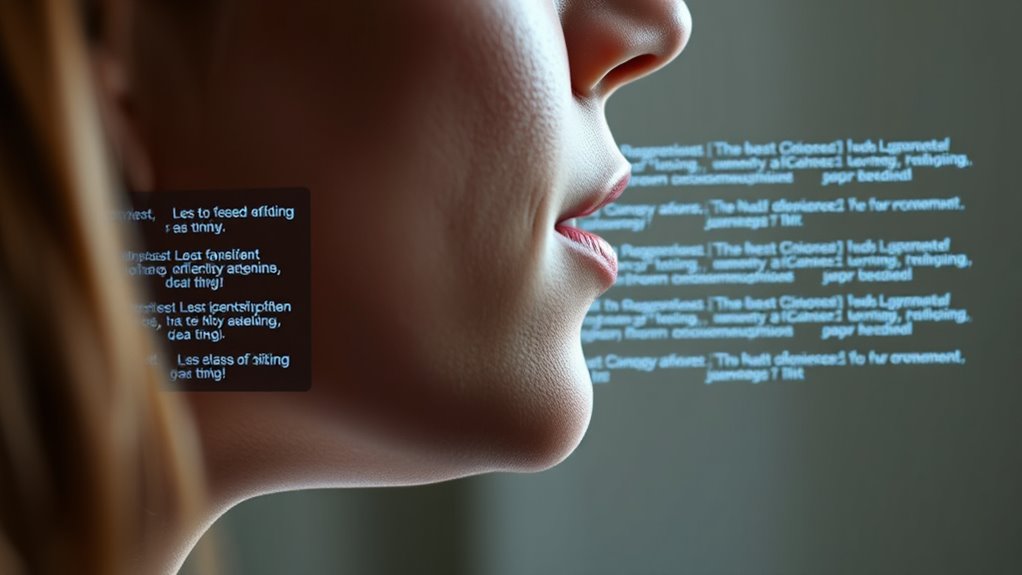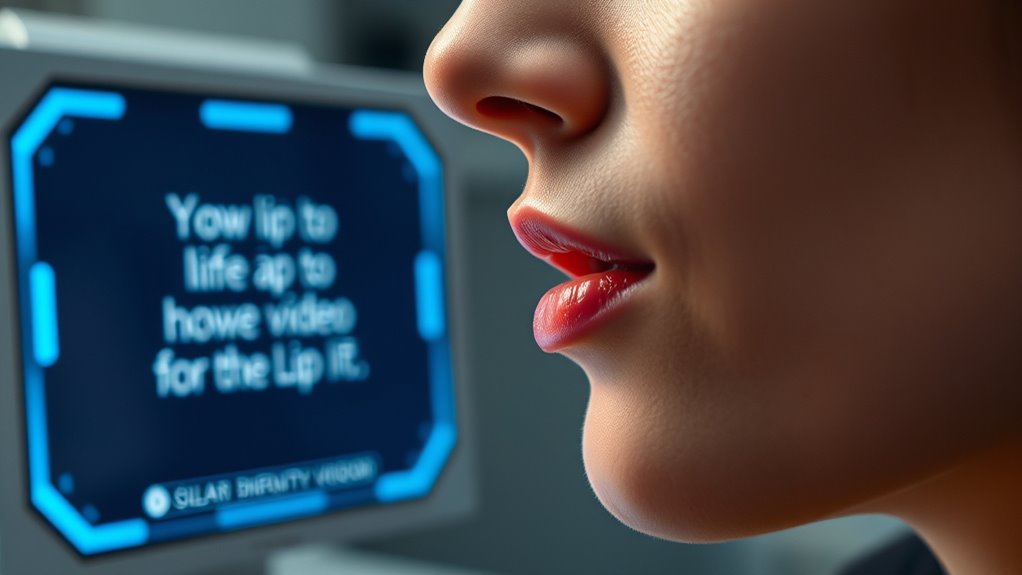Lip-reading AI transforms silent videos into text by analyzing lip movements, facial expressions, and gestures. Using advanced machine learning, these systems interpret subtle lip changes to provide accurate transcriptions, helping the deaf and hard-of-hearing communicate more easily. They rely on neural networks trained on large datasets, continually improving accuracy across environments. If you keep exploring, you’ll discover how these innovations are making communication more accessible than ever.
Key Takeaways
- Lip-reading AI analyzes lip movements and facial cues to transcribe spoken words from silent videos into text.
- Advanced neural networks and machine learning enable real-time transcription for improved communication.
- These systems process video data to interpret speech, supporting the deaf community in various settings.
- Ethical and privacy considerations ensure secure handling of video data and user consent.
- Continuous technological improvements enhance accuracy across diverse environments and speaker variations.
The Evolution of Lip-Reading Technology

The evolution of lip-reading technology has been driven by advances in computer vision and machine learning, transforming how machines interpret silent speech. Early systems focused solely on analyzing lip movements, but modern approaches integrate gesture recognition and facial expression analysis to improve accuracy. These enhancements have enabled more precise translation of silent video into text, especially in noisy environments or for users with hearing impairments. As technology progresses, the combination of gesture recognition and facial expression analysis continues to refine lip-reading systems, making them more reliable and versatile. Additionally, facial expression analysis helps AI better interpret emotional context, further enhancing translation accuracy. The integration of advanced algorithms has significantly increased the robustness of lip-reading AI, enabling broader real-world applications. Moreover, ongoing research into neural network architectures supports continuous improvements in processing speed and accuracy. This evolution marks a significant step toward seamless, real-time communication support for the deaf and hard-of-hearing communities. New developments in machine learning techniques are expected to further enhance system performance and adaptability, supported by ongoing innovations in AI training methods that improve model generalization and resilience.
How AI Interprets Lip Movements

AI interprets lip movements by analyzing the shape, position, and motion of the lips during speech. It uses gesture recognition to identify subtle changes, such as the opening and closing of the mouth or the curling of lips. Facial expression analysis helps determine context, like a smile or frown, that influences meaning. To understand speech, the system examines:
- The curvature of the lips during different sounds
- The distance between teeth and lips for vowel identification
- The speed and rhythm of lip movements
- The facial cues that signal emphasis or emotion
- The integration of advanced AI processing power allows for more accurate real-time translation and understanding. Incorporating machine learning techniques enables the system to improve accuracy over time through continuous exposure to diverse speech patterns. Additionally, ongoing research into neural network models enhances the system’s ability to recognize complex speech nuances.
This combination allows AI to decode complex gestures and expressions, translating silent lip motions into accurate text. By integrating gesture recognition and facial expression analysis, the system captures nuances humans use in spoken language. Empowering families with accessible communication tools can significantly enhance interactions for the deaf community. Additionally, leveraging real-time data processing enables immediate translation, further improving the effectiveness of communication support systems.
Key Components of AI-Powered Lip-Reading Systems

To accurately interpret lip movements, an AI-powered lip-reading system relies on several key components working seamlessly together. First, data preprocessing is essential; it involves cleaning and normalizing video data to remove noise and standardize input, ensuring consistent quality for analysis. Next, machine learning algorithms, especially deep neural networks, learn to recognize subtle lip movements by analyzing vast amounts of labeled video data. These models extract features from preprocessed images, capturing the nuances of speech gestures. The system then uses these features to predict the corresponding text. Continuous training and refinement improve accuracy over time. Additionally, considering dog names can inspire more engaging and relatable naming conventions for AI personas or project components, making technology more approachable. Incorporating model training techniques such as transfer learning enhances the system’s ability to adapt to diverse speech patterns and environments. Moreover, understanding speech articulation helps improve the system’s recognition capabilities across different accents and pronunciations. Implementing robust validation methods ensures the AI performs reliably in real-world conditions. Incorporating advanced image analysis techniques can further improve the accuracy of lip movement recognition. Together, data preprocessing and machine learning form the backbone of effective lip-reading AI, enabling it to turn silent video into meaningful, real-time text for the deaf community.
Challenges in Developing Accurate Lip-Reading Models

Developing accurate lip-reading models presents several significant challenges that researchers continue to address. First, data annotation is complex because labeling thousands of silent videos requires expert knowledge and time-consuming effort. Second, variability in lighting, angles, and individual differences makes it hard for models to recognize consistent patterns. Third, many models struggle with generalization, performing well on training data but faltering when facing new speakers or environments. Fourth, subtle lip movements and facial expressions are difficult to interpret accurately, leading to errors. These issues hinder progress in creating reliable systems, as models must learn from diverse, well-annotated datasets to improve their ability to generalize across real-world scenarios. Additionally, adhering to SQA Best Practices ensures thorough testing and validation of these complex models to enhance their robustness and reliability, especially considering the variability seen in real-world data. Ensuring robust training methods is vital for overcoming the inherent difficulties posed by diverse data conditions. Moreover, leveraging advanced data augmentation techniques can help models better adapt to diverse real-world scenarios. Incorporating diverse, annotated datasets is crucial for addressing the challenges of variability and improving model performance across different environments and speakers. Overcoming these hurdles is essential for advancing lip-reading AI.
Applications and Benefits for the Deaf Community

Lip-reading AI offers transformative benefits for the deaf community by providing a new way to access spoken language through silent videos. It enhances communication, especially in situations where sign language isn’t practical or understood. By integrating sign language options, the technology becomes more inclusive, bridging gaps between different communication preferences. Multilingual lip reading allows you to access spoken content across diverse languages, breaking language barriers. This technology can be used in live conversations, videos, and public broadcasts, making information more accessible. It also supports emergency situations where speech might be muffled or inaudible. Additionally, accurate lip movement analysis improves the reliability of the technology in various environments. Improvements in signal processing contribute to better performance, especially in noisy settings. Incorporating headphones can further improve audio clarity and context when used alongside lip-reading AI, especially in noisy settings. Furthermore, advancements in filtering background noise help the technology function more effectively in real-world environments. Enhanced machine learning algorithms enable the system to adapt to different speakers and lip movement variations, increasing accuracy. Overall, lip-reading AI empowers you to participate more fully in daily interactions, promotes independence, and fosters greater integration into social, educational, and professional settings.
Ethical and Privacy Considerations

While lip-reading AI offers significant benefits for accessibility, it also raises important ethical and privacy concerns. You must consider how consent requirements are managed—guaranteeing individuals agree before their videos are processed. Data security is critical; without it, sensitive information could be exposed or misused. Imagine a scenario where:
- Someone’s private conversation is inadvertently recorded.
- Unauthorized access compromises stored video data.
- Consent protocols are overlooked, violating privacy rights.
- Personal information is exploited for malicious purposes.
- Implementing security protocols for data protection is essential to prevent breaches. Ensuring data privacy and compliance with regulations is vital to maintain trust and protect user rights.
Future Developments in Visual Speech Recognition

Advancements in visual speech recognition are poised to make these systems more accurate, versatile, and seamlessly integrated into everyday communication tools. Researchers are improving neural networks to better interpret subtle lip movements and contextual cues, increasing recognition accuracy across diverse languages and accents. Future developments will likely incorporate more sophisticated speech synthesis, enabling AI to generate natural, expressive spoken responses from visual inputs. These enhancements will allow real-time translation, making conversations smoother for the deaf and hard of hearing. As neural networks become more robust, systems will adapt to different environments and lighting conditions, reducing errors. Ultimately, these innovations will lead to more intuitive, accessible communication platforms, bridging gaps and fostering inclusion in various social and professional settings.
How to Access and Use Lip-Reading AI Tools

To access lip-reading AI tools, you need to find reliable software or online platforms that offer these features. Once you’ve chosen a tool, setting up the software usually involves installing an app or configuring your device’s camera and microphone. Afterward, learn how to interpret the transcriptions the AI provides to effectively understand spoken content.
Finding Lip-Reading Tools
Finding lip-reading AI tools is now easier than ever, as many options are available online and through dedicated software platforms. You can explore tools that harness gesture recognition and facial expression analysis to improve accuracy. To get started, consider these steps:
- Search for reputable software providers with positive reviews.
- Check if the platform offers real-time transcription features.
- Look for tools that integrate gesture recognition to interpret hand movements.
- Make certain the software analyzes facial expressions for context and clarity.
Most tools are user-friendly, requiring minimal setup. Many also include tutorials to guide you through usage. By focusing on these features, you’ll find a lip-reading AI that fits your needs and makes communication more accessible.
Setting Up Software
Getting started with lip-reading AI software is straightforward once you know where to look and how to set it up. First, verify your device meets hardware compatibility requirements, such as a compatible GPU or sufficient RAM, to run the software smoothly. Most programs offer a user-friendly interface, guiding you through installation and setup without technical hassle. Download the software from trusted sources or official websites, then follow the prompts to install it on your system. Once installed, open the user interface to customize settings like video input sources and language preferences. Some tools also offer tutorials or quick-start guides within the interface, helping you navigate features efficiently. With everything configured, you’re ready to start converting silent videos into readable text.
Interpreting Transcriptions
Once you’ve installed and customized your lip-reading AI software, the next step is to access and interpret its transcriptions. You’ll often see the text output directly on your screen, which results from speech pattern analysis. To make sense of this data:
- Review the transcribed text for accuracy, paying attention to common errors from lip reading training.
- Use built-in tools to highlight unclear or ambiguous sections for manual review.
- Compare transcriptions with previous outputs to identify speech pattern variations.
- Adjust settings or retrain the AI if certain words or phrases are consistently misinterpreted.
This process helps improve understanding and ensures the AI stays accurate. Regularly interpreting transcriptions sharpens the tool’s performance, making communication clearer for the deaf community.
Frequently Asked Questions
How Accurate Are Current Lip-Reading AI Systems in Real-World Settings?
You might wonder about the accuracy of lip-reading AI in real-world settings. Currently, these systems demonstrate high visual accuracy in controlled environments, but their performance drops amidst background noise and complex scenes. They excel in contextual comprehension when videos are clear and well-lit, yet struggle with subtle lip movements or multiple speakers. Overall, while promising, these AI systems still need improvements to reliably serve diverse, real-world situations.
Can Lip-Reading AI Understand Different Languages and Dialects?
You might wonder if lip-reading AI can handle different languages and dialects. Today’s systems are improving in multilingual capabilities, but they still face challenges with dialect recognition due to pronunciation variations. While some models are trained on diverse datasets, achieving high accuracy across multiple languages and dialects remains difficult. As a result, lip-reading AI is advancing, but it may not yet reliably understand every language or dialect in real-world, multilingual settings.
What Are the Costs Associated With Implementing Lip-Reading AI Tools?
When considering implementing lip-reading AI tools, you should conduct a thorough cost analysis to understand the expenses involved. These costs include infrastructure needs like powerful servers and high-quality cameras, as well as ongoing maintenance and updates. You’ll also need to factor in licensing fees or subscription costs for advanced AI models. By evaluating these factors, you can better plan your budget and ensure a smooth integration process.
How Do Privacy Laws Impact the Deployment of Lip-Reading AI Technology?
Ever wondered how privacy laws shape new technologies? You realize that data privacy and legal compliance are vital when deploying lip-reading AI tools, especially since they process sensitive visual data. These laws require you to safeguard user information and obtain consent, which can slow down deployment and increase costs. You must navigate regulations carefully to guarantee your technology respects privacy rights while providing valuable services, balancing innovation with legal responsibilities.
Are There Any Limitations to Using Lip-Reading AI in Noisy Environments?
In noisy environments, lip-reading AI faces challenges like background noise and occluded lips that can hinder accuracy. You might find it struggles when there’s a lot of ambient sound, making it harder for the system to focus on visual cues. Additionally, if someone’s lips are partially covered or obscured, the AI’s ability to interpret speech diminishes. These limitations highlight the need for advanced algorithms or supplementary methods to improve performance.
Conclusion
As you explore lip-reading AI, think of it as revealing a silent symphony, turning quiet movements into meaningful words. This technology bridges gaps, giving voice to the deaf community and opening new doors of communication. While challenges remain, each breakthrough brings us closer to a world where silence no longer equals invisibility. Embrace these innovations—they’re the keys to transforming silent moments into clear conversations, connecting us all more deeply.











